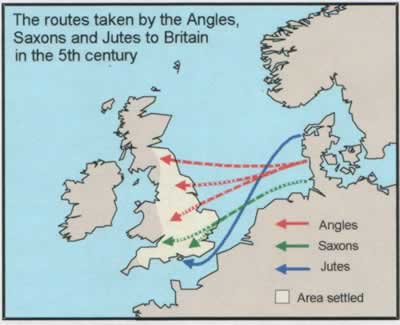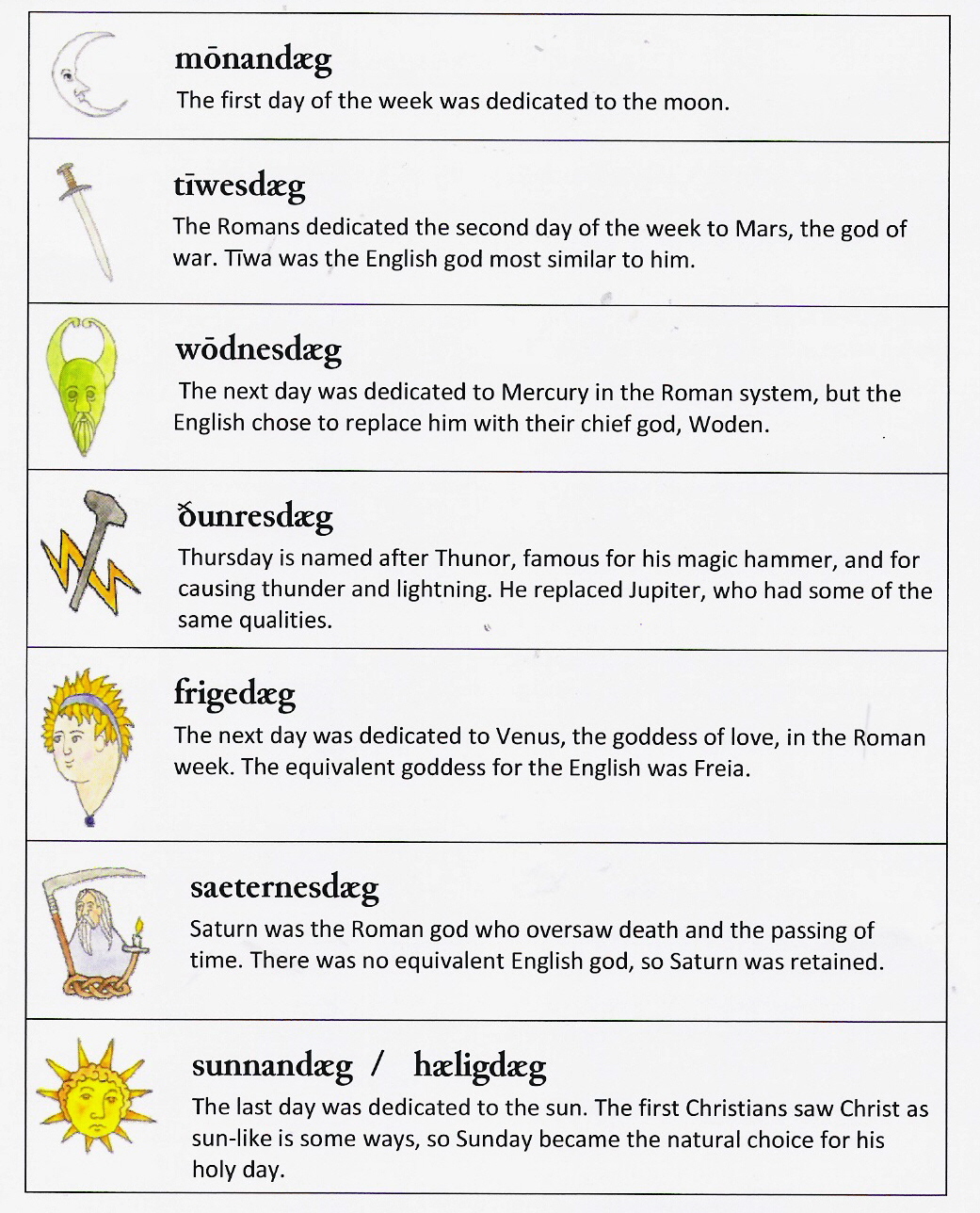Settlement in England

The Anglo-Saxons were Germanic invaders who came from what is now the Netherlands, Germany and Denmark. They were from the tribes known today as the Angles, Saxons, Frisians and Jutes and set up their own kingdoms in England. The Angles established themselves in the north and east, founding the kingdoms of Northumbria and East Anglia, the Jutes settled in Kent in the far southeast of England, the Saxons took the south of the country, naming their nations Wessex and Sussex. The Frisians made a home throughout the kingdoms of the other tribes, often working as traders.
Language

The Anglo-Saxons spoke various Germanic dialects which eventually evolved into the language Old English, which is the direct ancestor of modern English. A quarter of all English words come from Old English, although these words are very commonly used for everyday objects for example day, night, light, yes, he, she, god, cold and rain. Even today the closest language to modern English is still Frisian, the language spoken in the north of the Netherlands by the descendants of the people who became the Anglo-Saxons in Britain.
Weekdays

The Anglo-Saxons gave us the names for our days of the week. Names like Monday meaning “Moon-Day”. Tuesday was Tiw, the one-armed war-God’s Day and Wednesday, the day in honour of their chief God Woden, who was known as Odin to the Vikings. However the Viking God Thor was called Thunor in Old English, so Thursday is the only Viking based day of the week in the English language today. They also had names for the remaining days of the week, Friday was “Frigeday” for Frigg, the Anglo-Saxon name for Venus, Saturday was “Saternusdag” and Sunday was “Sunnandag”
Bad Neighbors

Archaeologists still don’t know what happened to the people the Anglo-Saxons replaced. After the Romans left Britain in AD. 420, the Romano-Britons were invaded from the west by the Irish and the north by the Picts, leaving the British king Vortigern with a desperate choice. The British monk Gildas writes that he sent word to several European tribes, inviting the warrior brothers Hengist and Horsa to fight as mercenaries against the invaders. Though they proved victorious against the Picts, the mercenaries soon turned on their masters and began to drive out their hosts. Historians know that the Anglo-Saxons conquered the centre of the island, leaving the Celts Scotland in the north, Wales and Cornwall in the west and in the south across the channel, Brittany.
However scholars don’t know what happened to the millions of people living in the land the Anglo-Saxons took over in what is now England and southern Scotland. Gildas suggested that the Britons were slaughtered in their hundreds of thousands by the invaders. New DNA evidence shows that males from Central England are genetically very distinct from those living a few miles west in Wales, whereas compared with the modern Frisians, they are almost inseparable suggesting a complete wipe-out of the pre-Anglo-Saxon population.
Metal Workers

As well as being bloodthirsty warriors, the Anglo-Saxons were skilled craftsmen and metal workers. Using gold and jewels from as far away as Persia, the Anglo-Saxons created beautiful artifacts such as this, the helmet found at Sutton Hoo in Surrey and the items found in the Staffordshire Hoard which was valued at £3.285 million after it was discovered in 2009.
King Arthur

Knights, round tables and damsels in distress may in fact be thanks to the Anglo-Saxons. The legend of King Arthur can be traced back to the Anglo-Saxon invasion when the Celtic Britons were being driven out of their ancient lands by the new invaders. The early form of the legend tells of a vision concerning a white and red dragon each representing the Saxons and the Britons. This red dragon is still on the Welsh flag today. Others tell us that Arthur was a British prince who stopped the Saxons at the siege of Mount Badon, near modern-day Bath. Whatever the truth behind it all, the stories of King Arthur and his knights are now timeless classics throughout the world.
Missionaries

When the Anglo-Saxons came to Britain they worshipped the old Germanic Gods like Woden, Thunor and Frigg, celebrating the harvests and the spring and summer solstices while conducting human and animal sacrifices. However this would change with the exiled Northumbrian King Oswald who sought refuge on Iona where he became a Christian. When he retook his kingdom from the Britons, the people there were forced to accept their ruler’s new religion, converting to Celtic Christianity which was brought to them by monks from Scotland and Ireland.
Soon all of England was Christian, but they did not stop there, instead choosing to return to Europe, the place their ancestors had come from. Many missionaries, especially from the northern kingdom of Northumbria travelled to the kingdoms of Frisia and Saxony to spread the gospel. While some were allowed to build churches and tend to congregations, others were less lucky like the monk Boniface who met his end at the hands of zealous pagans in the Frisian town of Dokkum where he was clubbed to death. At least his efforts made him a saint.
Creation of England

The Anglo-Saxons created the English nation. The word England is a compound of “Angle” and “land”, meaning “land of the Angles.” Before the arrival of the Vikings from Scandinavia, the Anglo-Saxons had lived in small kingdoms like Northumbria, Mercia and Wessex, without having a single king to rule over them all. However in AD. 865 the Vikings amassed a “Great Heathen Army” and took over the Anglo-Saxon kingdoms one by one, until only Wessex remained. A king Alfred fought against the invaders for decades, at one point even being forced to flee his capital at Winchester, and was forced to take refuge in the marshes of Somerset in the far west of England.
While fighting against the Vikings Alfred saw how weak the separate kingdoms had been and came up with the idea of one nation of “Englaland”, one nation with one king and under one god. Alfred’s kingdom remained free for the rest of his life, although it would be up to his grandson Athelstan who finally became king of England in AD. 925 after defeating the Vikings, the Scottish and the Cornish.
Mercenaries

After being defeated by the Normans in 1066, many Anglo-Saxons left Britain and sailed to modern-day Constantinople to fight for the Byzantium Empire. The Varangian Guard was an elite military unit set up by the Byzantine Empire in 874 AD as a personal guard for Emperor Michael III. Initially the unit had been made up of Swedish Vikings who’d sailed down the rivers of Russia and Ukraine, but after the Norman Conquest increasing numbers of Anglo-Saxon Englishmen joined the elite unit to fight against the enemies of the Last Roman Empire in the east. In 1088, 235 English and Danish ships sailed to Byzantium to join the Varangian Guard, which soon changed its name to “Englinbarrangoi” or “Anglo-Varangian”.
The Last Anglo-Saxon King was Buried in 1984

The last Anglo-Saxon king was buried in 1984. In AD. 975, a 15 year old named Edward was crowned king of England upon the death of his father Edgar. Edward was a bad-tempered young man and was murdered by his half-brother’s mother when visiting their household in 978. He was buried the year after in Shaftsbury Abbey but the grave was lost during the dissolution of the monasteries in the 16th However it was rediscovered in 1931 and preserved in a bank vault until 1984 when the bones were reburied.